#volcanic plug
Text



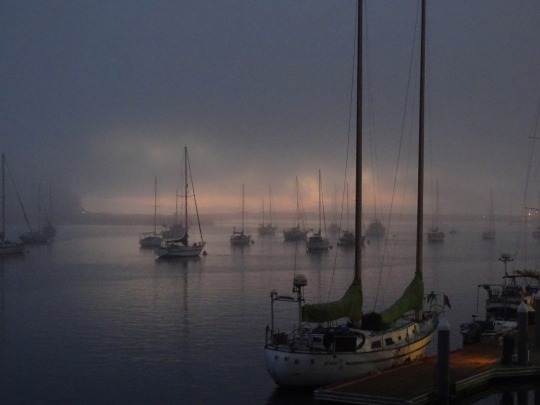

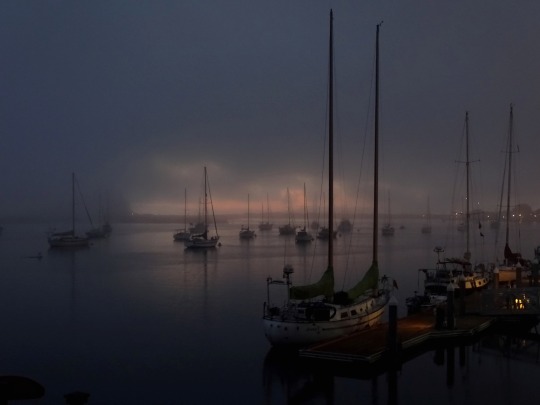
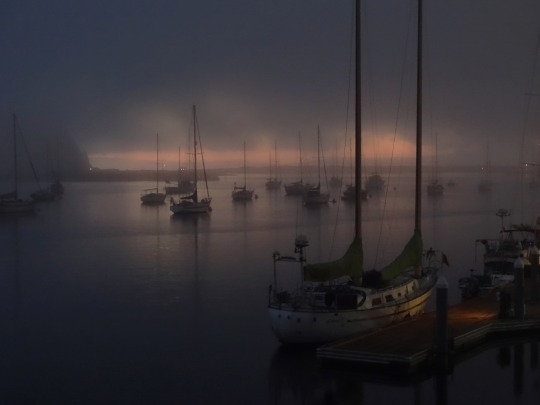



Morro Bay Harbor, CA (No. 3)
Morro Bay is the name of the large estuary that is situated along the northern shores of the bay itself. The larger bay on which the local area lies is Estero Bay, which also encompasses the communities of Cayucos and Los Osos. The city of Morro Bay is 20 km (12 mi) northwest of San Luis Obispo and is located on Highway 1. Los Osos Creek discharges into Morro Bay.
According to the United States Census Bureau, the city has a total area of 10.3 square miles (27 km2), of which, 5.3 square miles (14 km2) of it is land and 5.0 square miles (13 km2) of it (48.63%) is water.
Source: Wikipedia
#Morro Bay Harbor#Morro Rock#Morro Bay#Pacific Ocean#flora#nature#geology#volcanic plug#Santa Lucia Range#Nine Sisters#San Luis Obispo County#travel#original photography#vacation#tourist attraction#landmark#cityscape#landscape#seascape#summer 2022#USA#architecture#small town#boat#ship#beach town#summer fog#twilight#Estero Bay#dusk
8 notes
·
View notes
Text
Pico Cão Grande Is One of the Most Astounding Peaks on the Planet
If you want to experience what looks like a Lost World on Earth, book a ticket to São Tomé & Príncipe. This tiny island nation off the west coast of Africa is Portuguese speaking, and home to just 220,000 people. But it features some natural features that make it feel supernatural, including an astounding volcanic plug that rises like a giant tooth, 1200 feet into the air.
Called Pico Cão…

View On WordPress
0 notes
Text
Fact of the Day 27.9.22
The Devil’s Tower in Wyoming is the highest volcaninc plug in the world at 386m above the surrounding area (1559m above sea level).

#FOTD#FactoftheDay#volcanic plug#Kapsiki Peak in Cameroon is also pretty tall but I think the devils tower just beats it
0 notes
Text

Misti Volcano, Peru: Misti is a dormant volcano located in the Andes mountains in southern Peru, rising above Peru's second-largest city, Arequipa. It is a conical volcano with two nested summit craters, the inner one of which contains a volcanic plug or lava dome with active fumaroles. Wikipedia
80 notes
·
View notes
Text
So uhh... we found something really, REALLY strange
As the tectonic activity continues to shift ever more chaotically across the globe, randomly elevating or crumbling parts of mountains, opening up fissures and expanding fault lines, not to mention all the volcanic eruptions, to say it is important to monitor the inner workings of Earth would be a criminal understatement.
On the remains of what used to be Hawaii, now a singular landmass, lies a monitoring station closest to the epicenter of the Fusion Detonation Event, some 400km away. Seismographer and tectonics expert Joannie du'Preeste was finalizing this months deep level mapping of the area of detonation and directly below to give the algorithm-driven disaster prediction model at least an above 50% accuracy rate for this month.
Typical readings, increase in magma outflow, collapses of internal caverns, formation of new ones, and irregular shifts from the various efforts to stymie and direct the disastrous plate movements. Now that Humanity and Earth were properly back in dimensional space instead of in-between, some additional hectic activity in the form of directional nuclear detonation had been performed for the upcoming plan of "plug the hole with a large piece of another planet or moon".
They've selected Sycorax by the way, just waiting for it to get further away from Uranus in its irregular orbit, hook it up to several Dreadnoughts and haul it over to Earth and gently plop it in the hole. It is about the right size and nobody will miss it if it doesn't work.
Anyway, as she pondered the likely inevitable yet another calamitous event we'll be willingly conducting, the mapper finished its work.
At first, more of the same chaos as usual, but something at the back of her mind said to glance closer at the density readings from the deepest level measurements. With not much else to do today before the work day ends, she highlighted the appropriate levels, and as she started to remove clutter data, a shape began to emerge.
A tendril.
While scans and maps often show things that our minds interpret as something already familiar to us, once you look at each individual part, you see that it is just a coincidence. The brain wants to see what it knows to make sense of the unknown, life would be too complicated and overstimulating otherwise.
No mistake, however. As she removed more of the clutter and focused in on the object, there was no mistaking its resemblance to a biological structure. Hints of veins, pores, hairs, scales, needles, eyes... seemingly everything you could find on the surface layer of a creature was there, or parts of it anyway. Composition-wise it was more of the same silicates and such compounds found within the mantle. But... denser, more concentrated, almost deliberately shaped.
She quickly loaded up older data and after a bit of filtering and comparing, sure enough, the same tendril-like structure is there, just a little closer to the regular density levels of the surrounding. Even years old data provided similar results, though you could only find the shape if you already knew it was there.
Loading up the oldest records she had access to from around 300 years ago revealed the same, just even less distinguishable from the surrounding materials.
The scans don't go deep enough to show what the tendril leads to, if anything, but what is it? How did it get there? Why is something clearly biological in structure within the mantle layer? And if it does continue, how far? Does the core of the planet itself house some impossible creature? If so... what does that mean? For Earth? For Humanity? For the Universe? This is way above Joannie's pay grade and expertise, way past her regular waking hours as well at this point, and way too big to know how or if to reveal any information to the public. Some higher ups can have a headache instead.
Maybe the Coalition aliens know something similar.
Maybe this is all a big load of nothing and she just imagined it all.
Yeah.
That'd be nice.
Wouldn't it be nice if Cthulu wasn't potentially real?
#humanity fuck yeah#humans are space orcs#humans are deathworlders#humans are space australians#humans are space oddities#lovecrafian#fiction#short story#story#I'm not gonna tease and slow burn this#I suggested Cthulu exists in this verse so gotta advance that#how is this gonna work? dunno#I should probably read Lovecrafts works huh#cuz right now i'm just improving eldritch beings#also just casually dooming a moon to a pointless death#carionto
111 notes
·
View notes
Text

Terrance Haanen Images
**Shiprock is the common name for this iconic volcanic plug in Northwest New Mexico,
The Navajo name Tsé Bit aí, translates in
English to Rock with Wings **
88 notes
·
View notes
Note
i am asking you about tdt! remnant with particular interest in unhinged climate




it is so kind of you all to enable me (@meltedintoair @froginboillingpastawater @lemon-embalmer @blakistan)
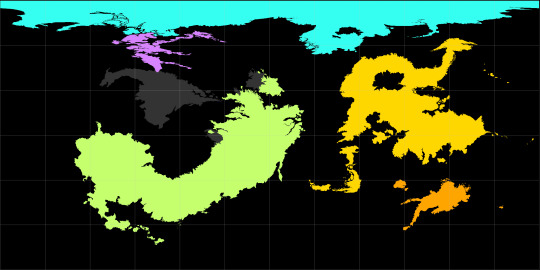
don’t mind the unfinished continent i’m still (through gritted teeth) figuring the strandlines out… also if you’re wondering why solitas looks like that it’s because for narrative reasons i needed land at the north pole here’s what she looks like Put Together
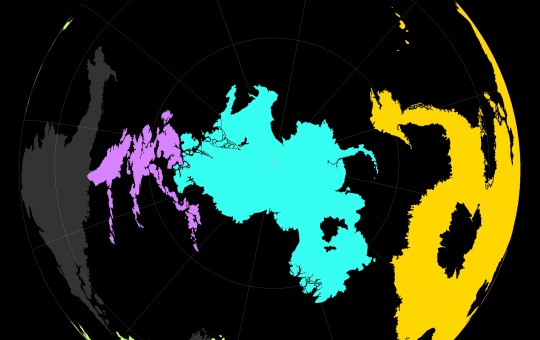
ANYWAY you will notice that i’ve moved things around. anima and menagerie north by a solid 30’ and rotated sanus a little bit counter-clockwise for the sake of not having vale and vacuo on almost the same latitude. mostly this is for the sake of bringing the various climates of these places into more reasonable bounds for an earthlike-ish climate—except for vale, which has a maritime climate with cool summers and coldish winters at 6’N, because i fixated on the puzzle of “earthlike climate except for this One Region” like you would not believe.
but before we get to Refrigerated Vale we have to talk about
✨the moons✨
yes moons plural. because i looked at the broken moon and heard the siren call of THE TIDES. tdt!remnant has three moons: mar, the original, which is (like the canon moon) not tidally locked and has a massive dark crater on one side (THE MOUTH OF THE MOON–), and the much smaller anthe + ogmios, which formed through the accretion of debris flung away when the god of darkness exploded the moon and are smaller.
INCIDENTALLY the hegemonic calendar is a lunisolar calendar with months correlating to mar’s cycle and 8-day weeks (octs) correlating to ogmios’ much shorter cycle; anthe is culturally associated with the god of animals and khimerism—that’s the monotheistic worship of the god of animals practiced by many fauni—has an anthean lunar calendar that is wildly different. the vytali common calendar has 12 months divided into 8-day octs (with some gnarly intercalation going on to align the calendar with the solar year); the khimeric calendar has 17 months divided into 9-day enneads with an intercalary month and handful of three-day-long leaping festivals that rotate the calendar through the solar year in a fifteen year cycle. it would be remiss of me not to plug fantasy-calendar for all your batshit calendar making needs. i have a spreadsheet where i pin down all the math and then just set everything up in FC it has never let me down.
back of napkin math:
on average the tides are about +/- 3.9 m. neap tides where all three moons pull against each other, +/- 3.7 m. spring tides where they line up, +/- 4.2—these are the open ocean tidal range, coastal tides are highly variable but as a very rough estimate tidal ranges along the (habitable) coasts are probably somewhere between ~2 and ~16m, with significant amounts of uninhabitable coastline where the tidal range is much larger and building on the high tide coast means your settlement is several kilometers inland at low tide. riverside building is also quite difficult because tidal bores are. pretty extreme
port cities don’t have harbors the way we think of them. they have either sprawling, complicated systems of locks operated by konurgists (=professional practitioners of dust-based magic) or they have cliffside dry docks designed for lightweight vessels to ride in and out with the tides. vale’s wharf district is a maze of locks and caissons. argus and kuo kuana have dry harbors.
the other thing about multi-moon systems is you get more significant tidal flexing ergo more volcanism
so where earth experiences ~70 volcanic eruptions per year on average, remnant the triple moon tsunami tides planet gets to have a “statistically there is always a volcano erupting somewhere in the world” trivia question, and all the air quality problems and acid rain you get from that.
SO the first consideration with regard to tdt remnant’s earthlike climate is that the conditions which produce it are very different; i… am That kind of person who back of napkin crunched numbers for all of this (and spent like an hour fiddling to not tidally lock the planet to the star 😭) BUT the numbers don’t matter per se; the salient piece is that the sun is both cooler and a little further away than ours (<- yes this IS me looking into the camera like i’m on the office about the god of light) and the planet is kept habitable by tidal heating, meaning the friction produced by the moons stretching and squeezing the planet as they orbit around it.
the moons stress balling the planet is also what causes The Volcanoes, which release greenhouse gasses (keeping remnant warmer than it would otherwise be) but also semi-regularly you’ll get enough big eruptions in clusters to Deflect The Fucking Sun like it’s 1816 and global temperatures nosedive and climates all over go haywire for a year or two. i think this happens on average about once per century but the current historical period—the seventh era—begins with a quarter century called the forge years when the planet got HAMMERED by four really bad volcanic winters in quick succession. think “14th century black plague” levels of decimation, except it was worldwide famines + just an explosion of conflicts and wars over food sources + grimm, whose populations spike whenever there’s a major volcanic event because the planet’s mantle is a mixture of molten rock and atrum (=grimm juice).
(there are very few true herbivores in this world. there are a lot of animals that eat plants when it’s warm and meat when it’s cold. true herbivores tend to be either animals that store huge food caches or animals that can go a really, really long time without eating. plants mostly either develop super deep root systems, or pump out antifreeze proteins when the temperature drops, or develop cold-mediated serotiny, or a combination.)
BECAUSE OF ALL THAT, remnant’s oceans circulate in a completely different way than ours; tidal heating warms the bottom water at the poles, causing it to rise in strong east-to-west or west-to-east currents, forcing colder surface water downwards and flowing towards the equator. consequently remnant does not have permanent ice caps, although most of solitas is perpetually snowy above its strandline.
(the strandline is where the water is at high tide; as noted in many cases this is several kilometers inland from the low-tide coast. anima, solitas, alukah—that’s the unnamed dragon continent—and sanus are all a single contiguous landmass at low tide, with huge land bridges exposed. it is generally not a good idea to try to walk, with the exception of one specific island chain that is small enough to traverse safely on foot by walking island-to-island over a span of about three days, four if you’re being cautious.)
the upshot of all this is it’s relatively warmer and wetter at the poles and cooler and drier at the equator compared to earth, because the oceans are effectively upside-down, warmest at the bottom near the poles. (if you’re wondering why the tidal heating is distributed this way, the real-world exemplar i’m working from is europa. interesting reading!)
northern anima is a bit of a special case because even though it looks coastal, it isn’t; the sea in between it and solitas is very, very shallow and at low tides is just this for hundreds of kilometers:
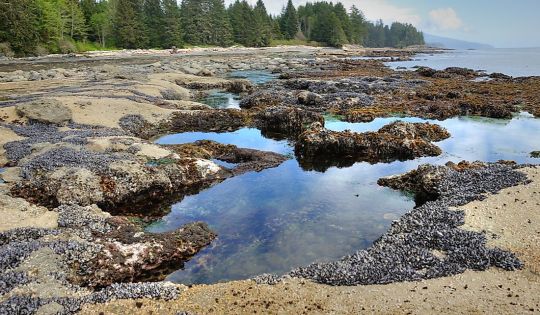
so within that curve of the “dragon neck” shape, the whole strandline is functionally landlocked with respect to the warm rising polar currents and during the wintertime can actually get colder than the region of solitas where mantle is located.
and then there’s the impact of dust.
i’ve drifted quite a bit off the basic ‘fantasy elements’ approach taken with dust in canon because the concept of dust as a sort of crystallized energy appeals to me; so there are four basic kinds of dust (thermal, electromagnetic, kinetic, chemical) which can be further divided into subcategories by their specific actions. for example most ‘burn’ and ‘ice’ dusts belong to the thermal family and are distinguished by whether they radiate heat or absorb it. and i say ‘most’ because there are also things like organic-solar/“bog” dust, which forms in peat deposits and produces heat but is classed as an electromagnetic dusts because it’s solar-powered.
large deposits of dust modify the regional climate in often dramatic ways. and this is how we get Refrigerated Vale—the difference between vale and other equatorial regions isn’t as huge as it would be on earth, because remnant’s equatorial band is relatively cool and generally falls more into a ‘warm-to-hot mediterranean climate’ than tropical, but vale is very noticeably cold for its latitude. there are Two Reasons for this.
one is what i’m calling the tarthic koniohaline climate system (TKCS pronounced “ticks”). the tarth sea—that’s the body of water surrounded by alukah, solitas, and sanus—has a huge, several-hundred-kilometer-long seam of variegated dust running along the southern continental shelf, roughly following the curve of the alukite/sanite coastline but further out to sea. (“variegated” meaning it’s a mixture of different types all sort of entangled together.) sort of akin to a barrier reef, but dust.
the tarthic dust formation is mostly a mix of absorptive thermal dusts (colloquially: frost) and kinetic dusts (colloquially: tidal) which together act to cool and desalinate water upwelling against the continental shelf, which is then pushed southward in a clockwise direction along the sanite/alukite coast. that produces a very cool, wet climate along the coastline with frequent thunderstorms as cold fronts coming off the water collide with warmer air rising from the vivax sea to the south (which again: think mediterranean).
vale sits on the southern periphery of the TKCS and is cooled by prevailing winds originating from the tarthic coast. it isn’t as rainy year-round as the vitrine peninsula but it does get quite a lot of precipitation.
the other factor Refrigerating Vale is that there’s absorptive thermal dust in the mountains, too. eastern vale—the counties in the northeast part of the continent, which were contested during the great war and (unlike in canon) not wholly lost to the grimm—has a very pleasant climate, warm summers and mild rainy winters, sometimes snow in the north and at higher altitudes. prevailing winds are fairly dry and warm when they hit the mountains and then rake over peaks that are just covered in frost/ice dusts and act as a giant heat sink, so western vale gets these bitterly cold, super dry winds pouring down the mountains during the summer that collide with warm coastal winds and cause huge storms. in winter the prevailing winds are much weaker, though still freezing, and blow further out to sea so there are fewer storms and infrequent snow but the snow that does fall tends to stick until the spring.
and that’s why the maragda valley is nicknamed the world’s refrigerator and vale’s chief export is various frost/ice dusts :)
OTHER FUN DUST-RELATED THINGS.
the southern part of alukah is called the mordicchiate coast and it’s one of the only regions in the world with a true tropical climate because it’s very, very rich in an assortment of kinetic dusts (mostly different grades of grav) that essentially cook the region by Vibrating Constantly
the other tropical region is in equatorial anima, a big swath of jungle and humid-subtropical grassland in what’s called the palash basin. it’s hot because it’s the caldera of an ancient supervolcano and one of the most volcanically active regions in the world. there are a lot of grimm. there are so many grimm in the palash basin. there’s also a strip of super-fertile land running along the northern rim of the palash region so people keep trying to live there anyway.
along the southwestern coasts of solitas (where those free villages are in arrowfell) there are just enormous underground seams of radiant thermal dusts which heat up the land enough that it’s possible to farm there during the summers; it still snows year-round, but the soil isn’t frozen so all you need is tents with clear panels you can uncover/cover to control sunlight.
the nequam desert—that’s the one surrounding vacuo—is also laced with radiant thermal dusts that bake what would otherwise be a warm arid steppe into a parched, burning-hot desert that wants to kill you. there are hotspots all over the place where the dust veins are so close to the surface that you can cook on the ground; nomadic desert peoples notoriously almost never use cooking fires and were instrumental to vacuo’s success in the great war because radar systems were still very rudimentary and no fires at night meant vacuan guerrillas could maneuver undetected until they appeared seemingly out of fucking nowhere to maul enemy supply convoys.
the wildlife in the menagerian interior are unique on remnant because there is a preponderance of electromagnetic and chemical dust formations on the surface—mostly “shock” dusts, which discharge or generate electricity—and the animals living have been in an evolutionary arms race for millions of years with the result that if it can’t generate electrical shocks on its own, it’s gluing electric rocks to itself decorator-crab style or it’s got specialized structures in its mouth that it can pack dust into and discharge shocks from when it bites you. “how can the wildlife be more dangerous than the grimm,” the rest of the world asks. “we have scorpions whose stings deliver an electric shock at a high enough voltage to kill you before you hit the ground,” says menagerie. “and lightning snakes. and an electrical tortoise. and storm bears–”
there’s a volcano called mount halog on the northwestern dragon-head peninsula of alukah that began to erupt in 332 VE—twenty-five years ago—and has been more or less continuously oozing lava and half-formed grimm ever since.
acid rain (and snow) is a worldwide issue because of the extreme volcanism and in rainy climates settlements exist in a more or less constant state of repair and reconstruction; once a settlement is abandoned it will fall into ruin very, very fast unless the climate is extremely arid. the most volcanically active regions in the world are northern alukah, the palash basin, and the east coast of anima; volcanic smog blows north to kuchinashi from the palash basin fairly regularly.
black rain is a very dangerous weather phenomenon caused by ateric ash—the stuff grimm disintegrate into when they die—floating up into the atmosphere and then precipitating down as liquid atrum. which. coagulates into new grimm. the drippings from the wyvern in canon are the same in principle but much more severe; typically black rains will spawn lots of small grimm—think rat- or cat-sized—and may not leave puddles large enough to form something like a beowolf at all. but a swarm of rat-sized grimm is still no picnic, and black rain is difficult to forecast, so within the vytal league it’s standard practice for huntsmen and grimm extirpation forces to be kept at the ready whenever heavy precipitation is expected, just in case it’s tainted.
the oceans are also quite a bit more acidic than earth’s and tend to be very nutrient-rich near the poles and barren with pockets of life here and there in the equatorial regions—which, as discussed in the Whale Post, in combination with the relative cold creates selective pressure for VERY LARGE akin to the phenomenon of abyssal gigantism but extended higher into the middle pelagic zones. the greatest diversity and density of oceanic life is around the north pole.
(the MONSTER WHALES are called hafgufa, females live in pods around the north pole, males are solitary and range worldwide.)
also,
because atrum does not freeze above absolute zero, and because the planetary mantle is atrum intermixed with magma, every spreading rift in the ocean also constantly pumps out rivers of atrum, which 1. plays an important role in moving and mixing waters to sustain those pockets of nutrient-rich waters where marine life flourishes in the equatorial regions, and 2. slowly but steadily spawns diluvian grimm. the VAST majority of grimm in the world are sea monsters born from these underwater rivers :)
#the guiding philosophy here is keep it in the neighborhood of earthlike but in a way that#only emerges through the interaction of these hellish extremes.#the brothers’ world was a paradise by divine fiat—without them remnant needs constant volcanism to be habitable.#through destruction: life.#the plate tectonics subordinate to the themes or else what’s the point. etc.
36 notes
·
View notes
Text
sneezing so hard i expel a magma plug from an active volcanic hotspot on the other side of the dreaming and also my tampon from my own body
26 notes
·
View notes
Text
MORRISON BASIN GEOGRAPHY
Today for Monday Musings I would like to discuss the paleogeography of the Morrison Basin. There are a few things I want you to learn from this:
-How do we know what it looked like in the Late Jurassic Morrison Basin?
-How do we know it was a basin?
-There were different environments/ecosystems within this very large basin.
Okay, so first. How do we know it was a basin? Easy, the rock record only records deposition (or lack thereof). Deposition happens in areas of low relief: basins. We can extrapolate where the highlands were from fluvial deposits and where we find them (i.e. where the conglomerates vs. the sandstones vs. the mudstones are in the system). As we move downriver from the source rock, the grains in the rocks get finer. Therefore, shales are found in places where movement is minimal such as a lake bottom or ocean floor and conglomerates are found closer to the source rock where fast flowing water could still move the larger grains. Here's a very simplified sketch of this concept:

How do we know what the land looked like? Well, we can find our answers in the rocks. In Canada, the Morrison is not used but there are equivalent rock layers: The Fernie Formation, the Morrissey Formation and the lower part of the Mist Mountain Formation. The Fernie Formation is primarily shales with a few sandstones, cherts, and limestones.


These rocks tell us that this is where the Sundance Sea was during the last part of the Jurassic Period. The Morrissey Formation is made of conglomeratic sandstones primarily with rare beds of mudstone, siltstone and even coal. This indicates a deltaic, nearshore (littoral), beach environment. This formation shows forested rivers emptying into the Sundance Sea.

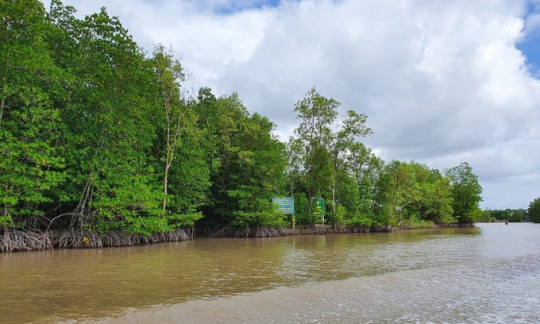
The Mist Mountain Formation is actually Late Jurassic-Early Cretaceous deposit. It is primarily shale, siltstone, sandstone, and mudstone. This formation represents fluvial channels, floodplains, deltaic, coastal plains and swamps along the Western Interior Seaway as it began to transgress back across the continent.

As we move south into Montana and Wyoming, we can see the environment start to change a little. The base of the Morrison here is the Windy Hill Member, a limey fossiliferous sandstone indicating warm, shallow seabed not unlike the Gulf of Mexico today. This is the extent of the Sundance Sea in the late Jurassic. By this point in time, the sea was regressing off the continent heading towards northwestern Canada and the ocean.


You can even see the white beach sand in the rock and the modern Gulf of Mexico! Neat! Following the Windy Hill in western Montana is the Swift Formation. This is also a marine deposit of primarily orangish brown, glauconitic sandstone. Commonly, it is filled with fossils. It is also shallow marine and some coastal deposits.

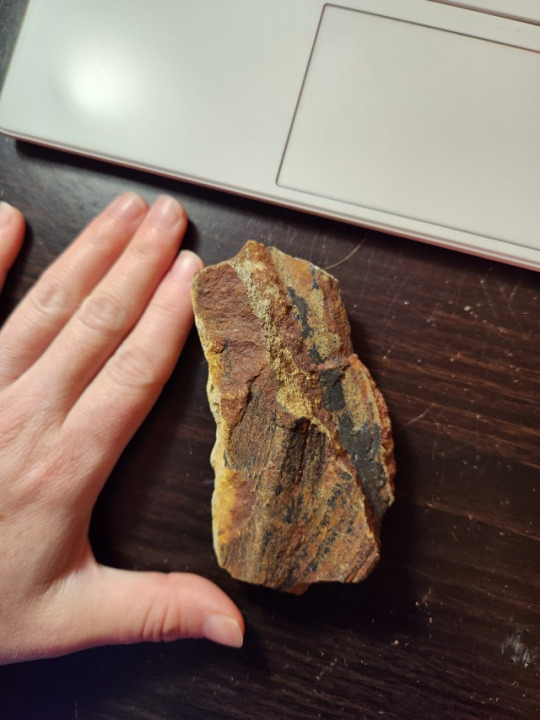
Next is the Morrison Formation proper. Like down south in the more famous outcrops, the Morrison in Montana consists of variegated mudstones and sandstones with minor limestones indicating fluvial and lacustrine deposits.

The biggest difference is that there is no clay change like on the Colorado Plateau (it doesn't become smectitic). This tells us there was no volcanic activity up north.
As we move south through Wyoming, the Morrison continues to have the typical variegated mudstone and sandstone profile, however, it has recently been noted to be mostly lacustrine (lake) deposits rather than fluvial (river). The basal Morrison in Wyoming is the Windy Hill Member (the regressive marine sequence). Perhaps the lakes were what was left after the sea retreated.
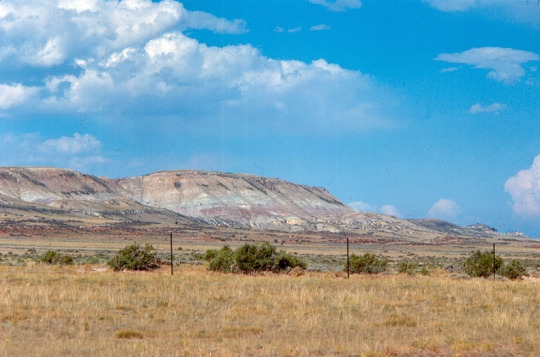

Northern Utah and Colorado are very similar to Wyoming with slightly more fluvial rocks than lacustrine, such as at Evil Tree Bonebed (I know, shameless plug but our site is so COOL). Things also start to show the clay change from illitic to smectitic showing that volcanism is becoming prevalent.
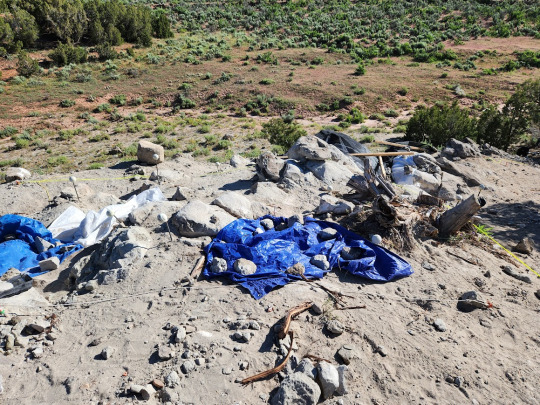

As we continue heading south through Colorado and Utah, more members are separated out and we see the seaonsal wet/dry cycles appear in the rock record. The Morrison down here is primarily fluvial sandstones and conglomerates and the variegated, smectitic mudstones.

(Grand Junction Morrison Formation)
As we continue south onto the Four Corners area, we become even more arid. In fact, there was a large saline lake there not unlike the Great Salt Lake in northern Utah now. It was called Lake Too'dichi and geochemistry tells us it was very saline and contained a lot of smectitic minerals that have aided in uranium ore development in the area.


(the Great Salt Lake from my plane home from GSA)
Lastly, in South Dakota and in the Colorado Plateau we find sand dune deposits ( Bluff and Unkpapa Sandstones) indicating small deserts forming.

So, when we put it all together, we make a paleomap that looks something like this:

Neat, right? You can see the retreating sea and the large river systems and the arid areas. I personally would put Lake Too'dichi on there too as it's like Great Salt Lake size but this is good enough for our purposes.
I hope you were able to learn something new and exciting about how rocks tell us about paleoenvironment and I will fossilize y'all later!
#paleontology#geology#fun facts#mineralogy#morrison formation#paleogeography#paleomap#paleoenvironment#prehistoric#geologic basin
9 notes
·
View notes
Text

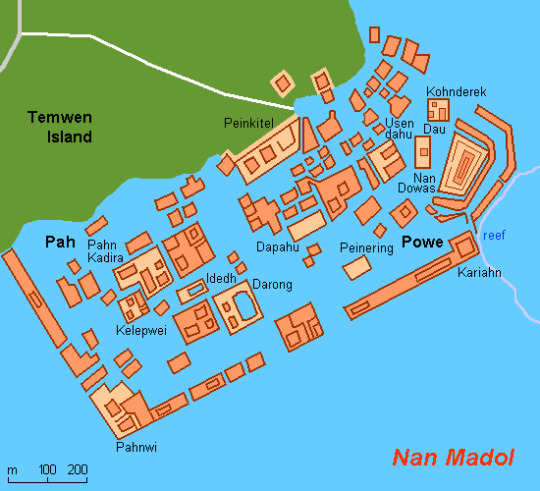
Nan Madol is an archaeological site adjacent to the eastern shore of the island of Pohnpei, now part of the Madolenihmw district of Pohnpei state in the Federated States of Micronesia in the western Pacific Ocean. Nan Madol was the capital of the Saudeleur dynasty until about 1628.[3][note 1] The city, constructed in a lagoon, consists of a series of small artificial islands linked by a network of canals.[3] The site core with its stone walls encloses an area approximately 1.5 km long by 0.5 km wide and it contains 92 artificial islets—stone and coral fill platforms—bordered by tidal canals.[9]
Carbon dating indicates that megalithic construction at Nan Madol began around AD 1180 when large basalt stones were taken from a volcanic plug on the opposite side of Pohnpei. The earliest settlement on Pohnpei was probably around AD 1 although radiocarbon dating shows human activity starting around AD 80–200.[13]
!!!
16 notes
·
View notes
Text
HP Astro #1: Severus Snape
Severus Snape is a Capricorn. That’s it, thank you, NEXT (jk, keep reading.)
(But maybe read this first: Astrology Introduction.)
Plugging in the information we know from canon (born: 9 January 1960 in Cokeworth, England), plus some time guesswork (or: me figuring out what time I needed to get Scorpio Ascendant), and this is what Severus' chart looks like:
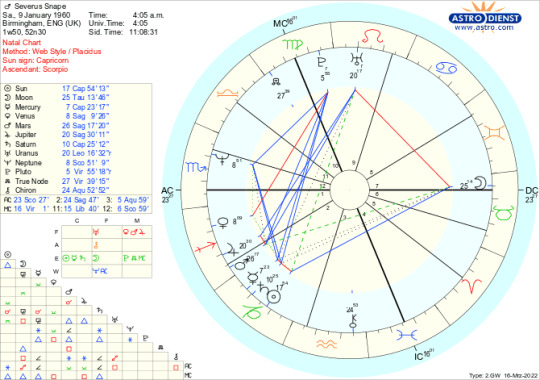
Capricorn Sun, sure! And Capricorn Mercury. And Capricorn Saturn. Taurus moon, too; and Virgo Pluto. A lot of Earth in this chart. A lot of solid, grounded energy.
But that's not all! There is also a ton of Sagittarius there. Venus, Mars, and Jupiter! Plenty of fire there. A specific flavor of fire. Sagittarius is a bonfire, or a campfire. A place of fun and gathering; exploration and storytelling and wisdom. It is the torch held by a seasoned adventurer. Passionate and searching, is Sagittarius energy. And that energy is found in love & pleasure (Venus), sex and violence (Mars), fortune and expansion (Jupiter.)
Sadly, the spontaneity and creativity of fire clashes with the practicality and responsibility of earth. Lose the war and you have scorched earth -- a person burnt out and exhausted. Or you lose control there's a volcanic eruption; all the hot danger of fire, channeled through the cool efficiency of earth. How do you balance energy that is so at odds?
As someone just as earth-and-fire heavy as Snape, I can tell you, I have no clue.
But in all fairness, neither does he.
Our man clings to control; clings to it. The sun is our core, and his core is the goat: responsible, resourceful, steadfast, reserved, practical. Capricorns have a deep sense of personal excellence that they strive for. If they have high expectations of others, they have higher expectations of themselves.
So: control. Control of the self. Control of your life, and your future. And...control of your surroundings. Control of others, even. Capricorn isn't only his core, but his ego and his pride. If he can't stay in control, he at least wants to be perceived as controlled.
His sun is also in the second house: money, material possessions. The second house isn't greedy, but desiring of material goods for the sake of security. That is where he stands, at the core of him, is that need for stability.
Then you factor in his history. The abuse, the bullying, the unending trauma...He was built for control, and his circumstances in life have him clinging to it like a lifeline.
It isn't only his ego that is colored by Capricorn, but his means of receiving and expressing information (Mercury: communication, learning.) And Big Daddy Saturn himself, planet of Discipline, is domicile in Capricorn (meaning the energy of the sign works seamlessly alongside the nature of the planet.) Severus is a man of structure, within and without.
Then we look at the moon, exalted as she is in Taurus. Sensual, romantic, and nostalgic...so too is it steadfast and loyal. His heart was built for affection. To share, to receive.
Worse still, his moon is in the seventh house: the house of Relationships. At the heart of him, Severus yearns for connection. There is a deep seated need to have deep, meaningful relationships.
And think about it. The few relationships he has in canon are pretty deep, and pretty meaningful, if not necessarily in the ways he might want. Think of his friendship with Lily. Their friendship meant the world to him. He was so devoted to her. His whole heart was in her hands (whether you see it as platonic or romantic is up to you.)
Then: Voldemort. He promised his allegiance in exchange for...what, exactly? Respect, maybe. Prestige. But more than that, I think. Saturn in Capricorn is telling. That placement is about law and order in some ways, and prestige in others. It was the dual need for success and righteousness. He believed in the cause, truly believed, for a time. And by committing to the cause, he was part of a community. He was given responsibility, and respect. For a time, he must have thrived as a Death Eater.
After, when he realized how wrong he was, he recommitted himself. He turned away from crime and looked towards redemption. He did so by transferring his allegiance, his obedience, to another: Albus Dumbledore. And with all of the relentless, merciless, flagellating drive of earth he gave his all to the cause. For what was right (Sun, Saturn) and for love (moon, second house.)
And what is being a spy if not connection? Not the connection he sought, maybe; not the connection he needed. But Severus is a man of control and practicality. He clings onto what he has. And he makes due.
I hate to tell you it gets worse, but...it gets worse.
The fire, remember? The passion! The liveliness! The creativity! All caught in the chokehold of earth's iron grip. Control, remember? But you don't control fire. You let it rage on, or you kill it.
Look at where you see Sagittarius. In Venus, the planet of love and pleasure. Mars, the planet of action and desire. Not only just sex and romance, but joy and fun. There is a spark in his heart. A raging inferno. He is made for drama, for experience! He craves a bit of adventure. It's a sign for idealism and optimism! It sounds nice, yeah?
For a man like Severus, all it means is undying hope. He clings to faith as much as he clings to anything else. In the darkest of times, in the roughest of circumstances, it keeps him going.
It's there in Jupiter, too. The planet of fortune is domicile in Sagittarius. This joyful energy entwined so perfectly with the planet of luck.
It's a lucky placement, they say, Jupiter in Sagittarius. Perhaps it's what kept him alive, what helped him succeed. It kept the spirit chained to his body when it might have fled from weaker men. Was it lucky for him? Maybe. Was it happy? Not so much.
We must also look at his ascendant. The mask we wear, in some respects; our defense mechanism in others. It is reactive. It is what is perceived.
And what do you think when you think of Scorpio? Dark intensity. Deep obsession. Scorpio is a curiosity. It is seductive. It is dangerous. It is the drop of water in the desert of Severus' life. But as all matters of Severus Snape, it isn't fun or pretty. Not an array of color on the ocean's surface, nor the splashing of the waves. Scorpio is the bottom of the sea. Hidden, and out of reach.
More than that, the ascendant tells us our chart ruler. Severus' chart is ruled by Pluto: planet of death and transformation.
Death is transformation, when it comes to divination. Death is change. Death is the end. Usually the end of one matter to begin another. One door closed so that another might open.
Death means cutting away the rot. Or being torn away from what we love, for our own betterment.
Death is renewal. And who has been cast through the crucible time and again? Who has walked out of the fire, shaped into a new tool, a new weapon, more times than Severus Snape?
Severus' life has been ruled by death, the way his horoscope is ruled by Pluto. The death of his time in Cokeworth. The death of his friendship with Lily, then the death of Lily herself. The death of his ideals. The death of hope. Time spent among the Death Eaters, working with and against them. Death hanging over his head like a pendulum. Death defeated in the Shrieking Shack once, perhaps twice (if you're as hopeful as I am.)
Death changed him, time and again. And time and again, he was reborn in the ashes.
There are pieces of Severus' chart that look so pretty on the surface. Taurus Moon in the second house. Sagittarius Jupiter in the first. In better circumstances, it might have worked well for him. In another world, he might be a prestigious potions master, lauded for his many achievements, and the envy of his peers as he lives on in domestic bliss.
He was built for it, as surely as he was built for the rest.
Instead, all of his ingenuity and courage and drive were sacrificed on the altar of the greater good. He stepped up and met every challenge. And when life shoved him down, he stood back up and kept trudging on. Driven by expectation and by courage. Torn between control and passion. Haunted by Death.
Severus never had it easy. Not from the world. And not from himself.
138 notes
·
View notes
Text
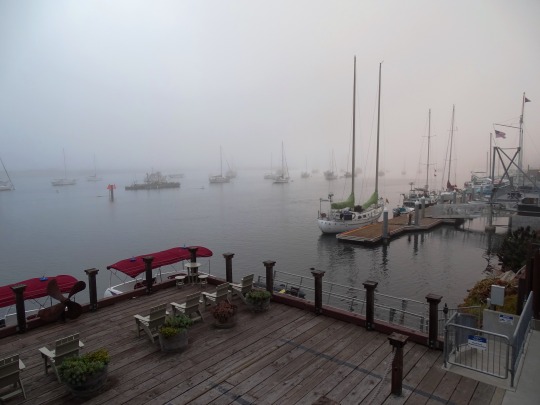

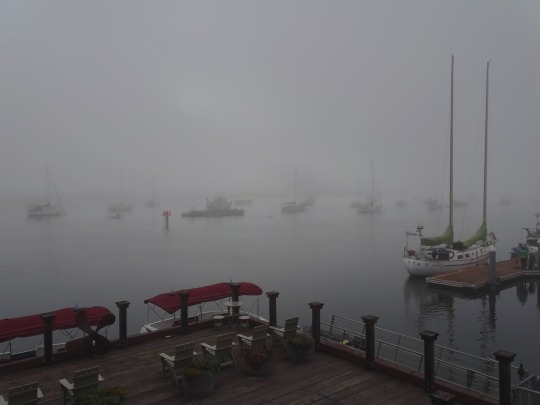




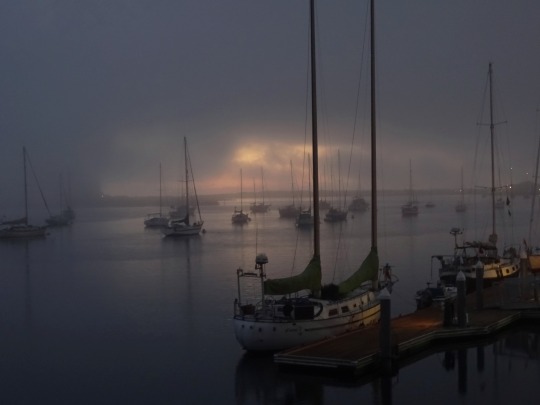

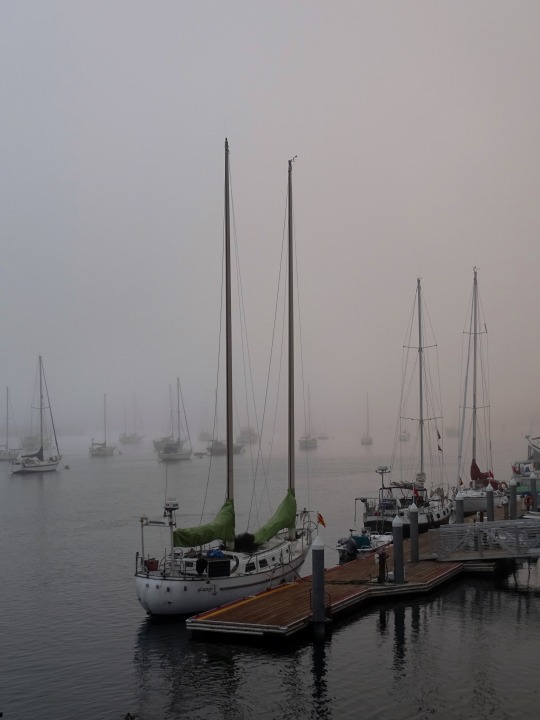
Morro Bay Harbor, CA (No. 2)
During World War II, there was a U.S. Navy base, Amphibious Training Base Morro Bay on the north side of Morro Rock where sailors were trained to operate LCVPs. The breakwater on the southwest side of the Rock was built in 1944–45 to protect the LCVPs entering and leaving the harbor. Soldiers from Camp San Luis Obispo would come to Morro Bay and practice loading into the LCVPs. Many of those men were at Normandy on D-Day.
In the 1940s, Morro Bay developed an abalone fishing industry; it peaked in 1957, and stocks of abalone have declined significantly due to overfishing. Halibut, sole, rockfish, albacore, and many other species are still caught by both commercial and sport vessels. In addition, oysters are aquacultured in the shallow back bay.
The Pacific Gas and Electric Company built the Morro Bay Power Plant in the early 1950s, which created jobs and increased the tax base. The city incorporated in 1964. The plant closed in February 2014.
Source: Wikipedia
#Morro Bay Harbor#Morro Rock#Morro Bay#Pacific Ocean#evening light#flora#nature#geology#volcanic plug#Santa Lucia Range#Nine Sisters#San Luis Obispo County#travel#original photography#vacation#tourist attraction#landmark#cityscape#landscape#seascape#summer 2022#USA#architecture#small town#boat#ship#beach town#summer fog
6 notes
·
View notes
Text
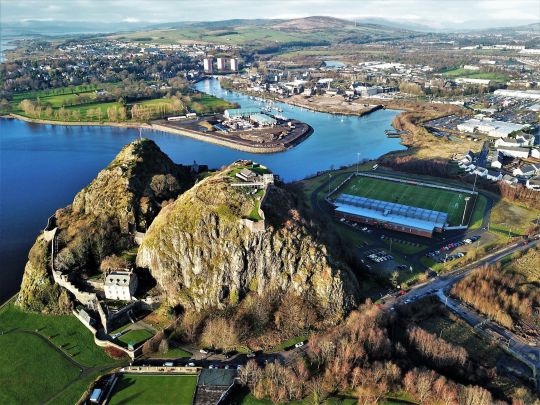




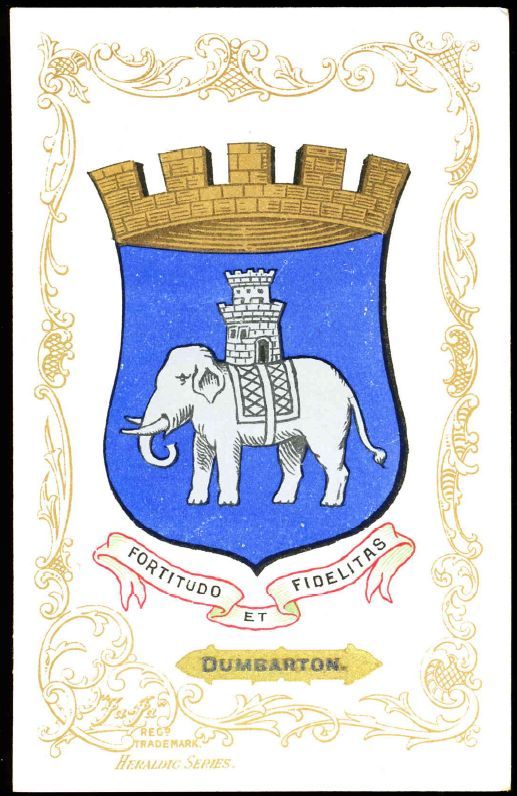
Scottish football club Dumbarton F.C. (currently in cinch League Two, 4th national tier) was founded in 1872. Their stadium is located directly next to Dumbarton Rock, a volcanic plug of basalt reaching 73m high. On top of the rock sits Dumbarton Castle or Dun Breatann (‘Fortress of the Britons’), who's history goes back as far as the Iron Age and the Early Medieval era, but most of the existing structures still remaining are from the 16th and 18th century. The castle served as a fortress as recently as World War II.
The team sports a club badge that "features an elephant with a castle on its back, [...] representing Dumbarton Rock (said to resemble an elephant) with Dumbarton Castle upon it, based on the historic town crest." Their nickname is "The Sons", taking meaning in "Sons of The Rock", term used to describe people born in Dumbarton.
#what a view!#scotland#scottish football#dumbarton fc#cinch league two#dumbarton rock#dumbarton castle
10 notes
·
View notes
Text
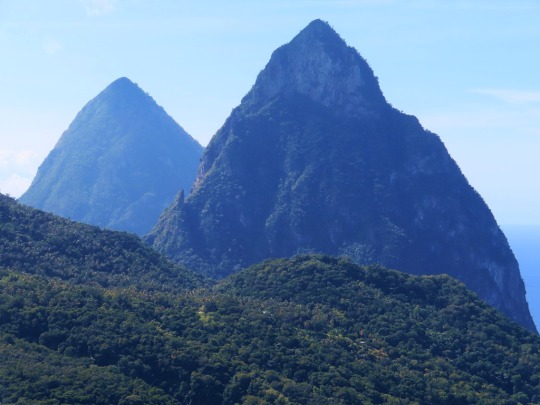
Of the two iconic volcanic plugs on southwestern Saint Lucia, Eastern Caribbean, Gros Piton (798 meters) on the left is far more easily climbed than Petit Piton (743 meters) on the right.
15 notes
·
View notes
Note
You know how your Saturn is the navigator and stuff? What roles do ALL the Stardroids play to assist each other? (And do they just live their lives with their hobbies, or do they have some form of work like planet conquering, or what? 👀)
Probably goes without saying, Terra and Sunstar are the leaders. While Sunstar easily brings a brute force, he's actually more likely to be reasoned with than Terra. However since he is mute, you'll probably have to deal with Terra anyway. All I can say is, good luck.
Mercury is primarily a scout/informant, and tying into that an infiltrator.
Venus is more likely to look into the life forms of planets they travel to- I like to say it was because he discovered earth had its own forms of crabs that it was spared. ;)
Mars is fairly obvious, artillery role. He's sent out before Sunstar though, the latter preferring to remain a last resort.
Jupiter is surprisingly, the grease monkey/tinkerer. He's got them bird feet for holding extra tools! He also has an interest in architecture and is responsible for any of the structures the Stardroids happen to build on invaded planets. Can also partake in scouting with his flight ability if need be.
Saturn is the resident cartographer, and quick transport - his ring aids him well in both of these!
Uranus's in depth knowledge of DIRT places him in a position of telling them just what kind of planet they're dealing with. Volcanic? Tundra? He'll know. He also likes cultivating different alien plants from their travels.
Neptune is actually the navigator here, both aiding in and reading off the maps Saturn designs. I like to think his big ol fins actually double as 'ears' in a way, he's capable of sonar. Equally useful underwater and when piloting a ship through space I don't doubt!
Pluto is about the only one I don't really have a designated role for yet. Been thinking but none have stuck so far.
Bonus: My interpretation of Ra Moon is also one of the Stardroids, and he accompanies Mercury in information seeking and infiltration, though less directly. His ability to plug into, read, and potentially rewrite other robot brains comes in quite handy.
26 notes
·
View notes
Text
Your NPC Candidates!
The top five most submitted, in order:
Ayda Aguefort
Gilear Faeth
Garthy O’Brien
Wuvvy
Jawbone O’Shaughnessey
The rest of the 149 candidates, grouped by season:
Esme
Scratch
Viscountess Grabalba
Wannessa
Captain Gorebladder
Princess Suntar
Philippa “Peep” Featherfowl
Scorple
Sir Keradin Deeproot
The Sugar Plum Fairy
Manta Ray Jack
Stilton Curdeau
Cinnamon
Gooey
Swifty
Peppermint Preston
Duchess Primsy Coldbottle
Annabelle Cheddar
Queen Caramelinda of House Rocks
Sprinkle
Lord Calroy Cruller
Limon Longhalls
Senator Augustus Ciabatta
Spearia Mentha
Pontifex Belizabeth Brassica
Viscount Thaddeus Strongpit
The Junkmother
Aurora Nebbins
Plug
Princeps Zorch
Loose Duke
Barry Nyne
Raymond Zam
Lucienne Rex
King Prilbus
Plinth
Natalia Cicero Connie Lee Carter Bajar
Bambi Leroux
Hyacinth Khrome
Stacks McFadden
Rising Bubbles from a Deep Volcanic Vent Many Fathoms Below Us
Veep 909
Zvoon
Drago
Jessa
Avanash
John Feathers
J'er'em'ih
Percival son of Paraval (Stalker)
Ol' Pickering
Bad Henry
Master Ipskix
Drova Longfoot
Galfast Hamhead
Olag
Telmeir the Calm
The Cubbies
Ragh Barkrock
Zayn Darkshadow
arthur aguefort
Tracker O'Shaughnessey
Sandra Lynn Faeth
Gorthalax the Insatiable
The Hangman
Cathilda Ceíli
Aelwyn Abernant
Bogariel “Boggy the Froggy” Frogariel
Zelda Donovan
Alistair Ash
Biz Glitterdew
YES! (the deity)
“Baby” Wretchrot
Jamina Joy
Baron from the Baronies
Chungledown Bimothy
Madam Silvaine
Little Gilear
Telemaine Lomenelda
Craig
Rawlins
Laertes Astrindarius
Karl Cleaver
Gelgador
Talura
Athena Jones
Preston
Holly
Koda the bear
Lucia Wallace
Lysander Higgins
Starforge
Taffodil
Bill Seacaster
Sklonda Gukgak
Digby & Wilma Thistlespring
Zaphriel “the Hangvan”
Nonna Wallace
Kalvaxas “Goldenhoard”
Pok Gukgak
Matila Molesly
Alphonse
Senator!
Little Miss Muffet
Scheherazade
Princess Elody of Greenleigh
The Stepmother
Lord Bandlebridge
Stephan
the Dish
Mayor Harold Hopps
Mira (the Little Mermaid)
Rapunzel
Cinderella
Candlewick
the Big Bad Wolf
Il Terribile Pescecane
Peter (the Baron of Bricks)
Nod
Stephen Sondheim
Dale Lee
Jackson Wei
The Questing Blade
Wally Kugrich
David Kugrich
Willy
Em
Lowell Masters
Esther Sinclair
Alejandro Ortiz
La Gran Gata
Liz Herrera
53\/3N
Perry the Pigeon
Pizza Rat
Don Confetti
Dr. Lugash Primjitzski
Yagdash Scrovich
Ronaldo Manticaster
Dylan
The Incredible Dantes
Speck
35 notes
·
View notes